Using laser distance meters in bright sun
-
So what if the walls are not perfectly straight?
Lots of buildings have tapering walls, like Inca buildings, fortresses etc, and many have walls skewed by time/age and bad foundations, like the tower in Pisa etc.
Pythagoras won't help much then, will it?
I'm sure the Leica Disto D8 is a very useful tool, that can also do some angle measurements afaik, but will it be enough power/precision for such situations?
And with a price tag a lot higher (at least in this country ~US$1400) than the tgi3D/PhotoScan I know what I would have chosen But a cheap Bosch laser would probably be quite useful for measuring a reference distance. So far I have gotten enough precision with a 5m tape measure.
But a cheap Bosch laser would probably be quite useful for measuring a reference distance. So far I have gotten enough precision with a 5m tape measure.A bit OT:
A little while ago I saw a TV program from a volcanic rift (?) in Ethopia(?) where the team wanted to make a 3D scan of the extremely hot rift which puffed out toxic gases all the time. They rigged the laser scanner on a steel cable crossing the rift, and lowered it down to make the scan. They had to give up after a while, but they did get some parts of it 3D scanned. I can't help but smiling a little at their efforts, when they could have used the KISS principle and easily/safely gotten good results using PhotoScan (or similar software like PhotoModeler) -
@mitcorb said:
Similarly Leica lets you do a Pythagorean process to arrive at building heights, or other distances.
Yeah, I wished I could get one of those but mine does not do Pythagoras. Of course, I can do it if I really need to

@bjornkn said:
Lots of buildings have tapering walls, like Inca buildings, fortresses etc, and many have walls skewed by time/age and bad foundations, like the tower in Pisa etc.
That's true however the majority of buildings are (fortunately) rectangular/vertical (more or less). If not, we get out our secondary school geometry books again and do some calculations.

-
@gaieus said:
That's true however the majority of buildings are (fortunately) rectangular/vertical (more or less). If not, we get out our secondary school geometry books again and do some calculations.

Wonder how those formulas look?
-
The book are in the attic ATM. I should get them down one day...

-
SOH-CAH-TOA:
Sine = Opposite ÷ Hypotenuse Cosine = Adjacent ÷ Hypotenuse Tangent = Opposite ÷ Adjacentor
Some Old Hippy Caught Another Hippy Trippin' On Acid
-
@gaieus said:
I also have a Bosch meter and it has a function to measure the shortest or longest route you are "sweeping through". Here are two, quick sketches what it does:
DOH! Thanks, I don't remember seeing this in the instruction sheet. But then the whole thing looked so simple that I tossed the instruction without reading. Thanks Gaieus.
-
Well, devices of even the same brand can be very different so there may not be this function on yours. Yet of course looking it up would be best.
-
@Roger :
Afaik sin/cos/tan only works on right-angled triangles, and so do the Pythagoras rule a^2+b^2=c^2 - or here : a=sqr(c^2-b^2)
That's why I was so interested in the formulas in Gaieus' books. Too bad they are in the attic
BTW, did you get that iPhone theodolite to work with any precision?
-
Bjorn, any triangle can be divided into two right triangles, each of which can be solved by pythagoras or sohcahtoa.
-
@roger said:
Bjorn, any triangle can be divided into two right triangles, each of which can be solved by pythagoras or sohcahtoa.
Yes, as long as you know some angles?
Or if you measure from 2 positions? -
While we are on 'formulas'...
If you know two sides of any triangle and the angle between them then you can find the length of the other side opposite that angle using the Cosine Rule
a^2 = b^2 + c^2 - 2bc*cosA
can be rearranged to give the sideathus...
a = sqrt(b^2 + c^2 - 2bc*cosA)
Notes:
Side 'a' is opposite angle 'A'.
There are obviously the other two versions of the equation for the two other sides, but you can give them the reference you want so you always find 'a' without needing to have these in memory!The Sine Rule works for any two angles and one related side, from which you can find the another side
a / sinA = b / sinB = c / sinC = D
which can be rearranged to give the sideathus...
a = b * sinA / sinB
Notes:
Side 'a' is opposite angle 'A' and so on.
The ratios are all equal toD, which is the diameter of the circle that passes through all of the three vertices of the triangle - the radius of that circle isD/2.
To find the area of any triangle where you know two sides and the angle between them use
Area = a * b * sinC / 2
-
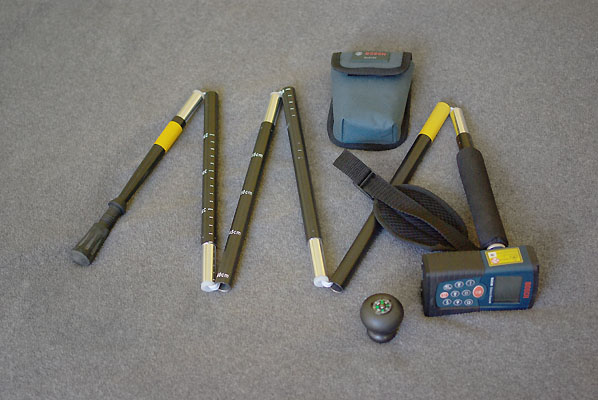
My folding meter stick with distance measure on top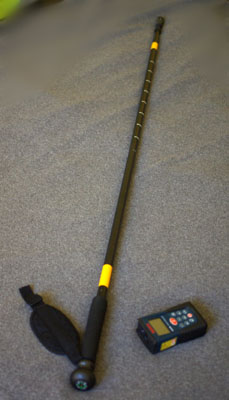
Stick unfolded - the distance (outer edge to outer edge) of the two yellow reflective tapes is 3ft.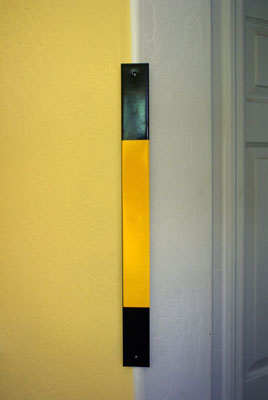
Laser target bar hung magnetically on wall corner. Reflective tape is 1 ft long and entire black bar is 22 inches.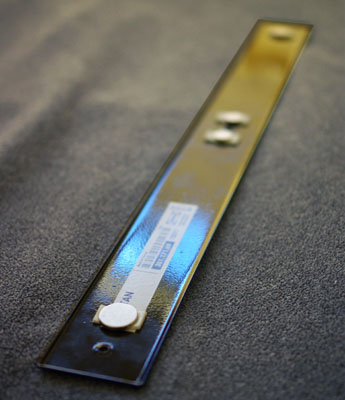
This is the back of the target bar. The circles are neodymium super magnets affixed with double sided tape. There are also holes in the bar that can be used with push pins, nails, strings, picture hooks, and clamps.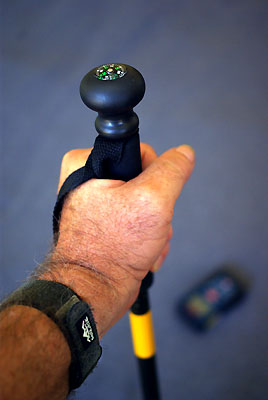
This is the stick with compass
Compass remove and distance meter in place. -
@tig said:
While we are on 'formulas'...
If you know two sides of any triangle and the angle between them then you can find the length of the other side opposite that angle using the Cosine Rule
Exactly!
But you need to know one angle (which may be 90 degrees) and 2 sides to calculate the length of the third, right?
With only 2 sides and no angle you can't know the length of the third side?
But if the wall is vertical (90 degrees) you can calculate without using sin/cos, but just the a^2+b^2=c^2? -
Is there a built-in level in the Bosch laser then?
-
@bjornkn said:
Is there a built-in level in the Bosch laser then?
I am designing and building an accessory to attach a level and a small monocular and the whole device will clip to my meter/yard/walking stick.
-
@bjornkn said:
@roger said:
Bjorn, any triangle can be divided into two right triangles, each of which can be solved by pythagoras or sohcahtoa.
Yes, as long as you know some angles?
Or if you measure from 2 positions?Two angles with the enclosed side or two sides and the enclosed angle. And if you know one angle to begin with and divide the triangle into two right triangles you will know your first angle, your second angle will be the right triangle (90 degrees). Then if you add known angle to 90 degrees and subtract the result from 180 degrees you know the third angle.
-
@bjornkn said:
Is there a built-in level in the Bosch laser then?
You did not fully understand the point of Gaieus' diagram and comments. As you sweep the meter up and down the distance reading will change. It starts out long reaches its shortest point and then gets long again. The angle where the distance is shortest is a perpendicular to the wall. When the distance is the shortest, you have a 90 degree angle between the wall and the laser line.
-
Also don't forget the 'Similar Triangle' method to get the height of something too tall to measure directly - this uses 'bright-sunlight' because it has to have a shadow - no gadgets required!
-
@roger said:
You did not fully understand the point of Gaieus' diagram and comments. As you sweep the meter up and down the distance reading will change. It starts out long reaches its shortest point and then gets long again. The angle where the distance is shortest is a perpendicular to the wall. When the distance is the shortest, you have a 90 degree angle between the wall and the laser line.
Yes, I understood that. Nice feature
 I was just curious if the Bosch lasers come with a level built-in, as I might be interested in buying one. Could be useful for measuring/calculating a longer reference, for use with tgi3D, than what is easily measured with a 5m tape measure. The longer the reference, the better the precision.
I was just curious if the Bosch lasers come with a level built-in, as I might be interested in buying one. Could be useful for measuring/calculating a longer reference, for use with tgi3D, than what is easily measured with a 5m tape measure. The longer the reference, the better the precision.
My Android phone has a built-in level (but the back side is slightly curved...) and I know that some laser devices are self-levelling, thus I wouldn't be surprised if the Bosch had a level too. And the iPhone probably have an app too?Re. angles and measuring distances:
My question was how to calculate a height if the walls are not exactly vertical, based on only distance measurements from one position.
Gaieus' method will work for vertical walls, and the method with pointing upwards should work too, if there is something there to stop the beam, like a roof, or maybe a board laid on top of a fortress wall etc?
Like TIG explained you need the length of the 2 sides + the angle between them to calculate the third side. As long as the triangle does not have a 90 degree angle (like with a non-vertical wall) you cannot use only distances, but need one angle as well.@Gaieus:
What is the model number of your Bosch? -
@tig said:
Also don't forget the 'Similar Triangle' method to get the height of something too tall to measure directly - this uses 'bright-sunlight' because it has to have a shadow - no gadgets required!
Nice, but it does require a vertical wall and a flat ground, which we rarely have here in Norway

Like this photo of our local fortress shows..
No flat ground, no vertical walls, and no right angles anywhere at all actually.
Advertisement







